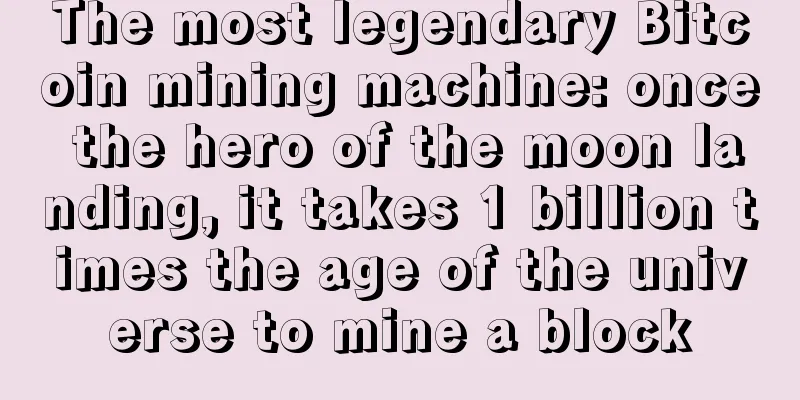The most legendary Bitcoin mining machine: once the hero of the moon landing, it takes 1 billion times the age of the universe to mine a block

|
Some people are so obsessed with the word “can” that they never think about the word “should.” Recently, one person has converted the Apollo space mission guidance computer (AGC) into a Bitcoin mining machine. Image source: pixabay Bitcoin mining machine that landed on the moonKen Shirriff is a man with a passion for restoring vintage computer hardware. For his latest project, Shirriff got a guidance computer from an Apollo space mission and made it work again; in his opinion, it's the only example of a workable system. This computer was small enough to fit on the actual Apollo spacecraft, even though most computers used during the Apollo moon landings ranged in size from refrigerators to entire rooms. Of course, once you have such a machine, you should give it something to do. After all, there aren't that many moon landings to give it direction. But what function does it have? In Shirriff’s own words: “Trying to mine Bitcoin on this 1960s computer seemed both pointless and anachronistic, so I had to give it a try.” As you might have guessed, implementing the SHA-256 hashing algorithm on this 15-bit machine is difficult. However, Shirriff succeeded, as shown in the video below. As you can imagine, this machine is far from the fastest mining machine. One SHA-256 hash takes 5.15 seconds, and since Bitcoin uses double hashing, it works out to just under 0.01 hashes per second. At this rate, Shirriff calculated that it would take about 1 billion times the age of the universe to mine a single Bitcoin block. However, this is not the slowest method of bitcoin mining he has tried. His previous projects have included mining using an old punch card computer system and even mining a block by hand. In comparison, the punch card experiment was able to calculate one Bitcoin hash in 80 seconds, while the rate of calculating hashes using pencil and paper was 0.67 per day. Obviously, none of this will make Shirriff a Bitcoin millionaire. But he should be applauded for his commitment to preserving computing technology from the past. Let’s just hope he doesn’t convert any more Apollo guidance computers into mining rigs. Or maybe Cambridge University’s project to calculate the real-time Bitcoin network’s energy requirements will have to recalibrate its worst-case efficiency scenarios. |
<<: The battle for high-performance mining machines
Recommend
What are the five sense organs and how do they relate to one's destiny?
The five facial features refer to the five human ...
Frogbit, register and get $400 of Bitcoin cloud computing power, spot sale!
Register as a new user to enjoy gifts, register n...
The palm reading of Yi Chengkuo's wife
The palm reading of Yi Chengkuo's wife Becomi...
Shanghai releases Lingang New Area innovative industrial planning involving multiple blockchain technology R&D applications
The Shanghai Municipal Economic and Information C...
The facial features of people who are prone to hurting others if they disagree with something
In fact, we all say that a gentleman uses words r...
What are the facial features of women who are remarrying? These types of women are prone to divorce due to bad relationships
Marriage cannot be compromised. If two unsuitable...
People with uneven foreheads can benefit from a noble person
Everyone's facial features are different, eve...
ETH’s Road to $5,000: Near-Term Catalysts and Medium-Term Outlook
The cryptocurrency market has experienced a major...
Bitcoin returns to $12,000 for the sixth time. Whether it can form a support level will be the key
Bitcoin (BTC) bulls gathered enough strength on W...
What does it mean for a woman to have a widow's peak? What is her fate?
What does it look like for a woman to have a wido...
The fate represented by a mole on the palm
Many people say that having a mole on the palm is...
Three new upstarts emerge to challenge the central position of exchanges: MetaMask OpenSea and Coingecko
Wu said author | Colin Wu Editor of this issue | ...
Is it good luck for women with thick lips? What are the advantages of thick lips?
Everyone's lips are different. Some people ha...
How to read the career line of men's palm
In palmistry, the lines extending from the palm t...
What does it mean when a man has a mole on his right palm?
Moles on the palm are generally rare, so the mean...









